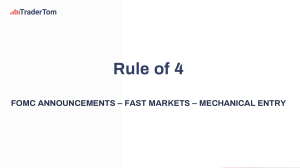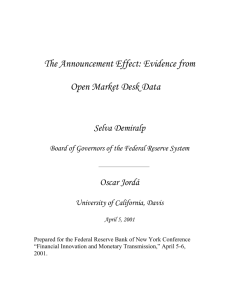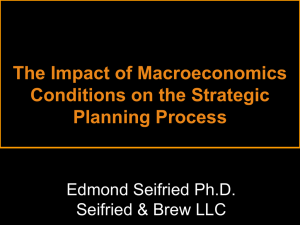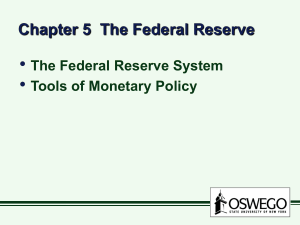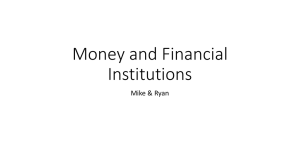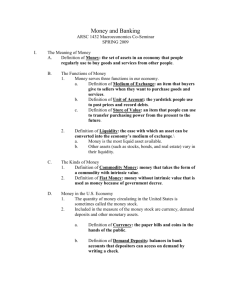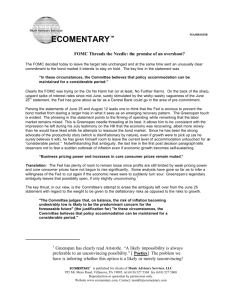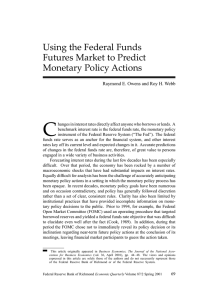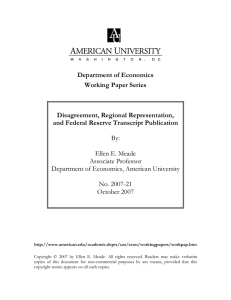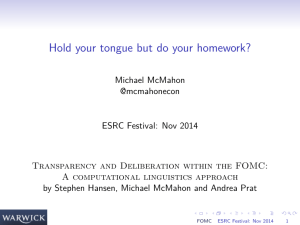Additional Documentation
advertisement
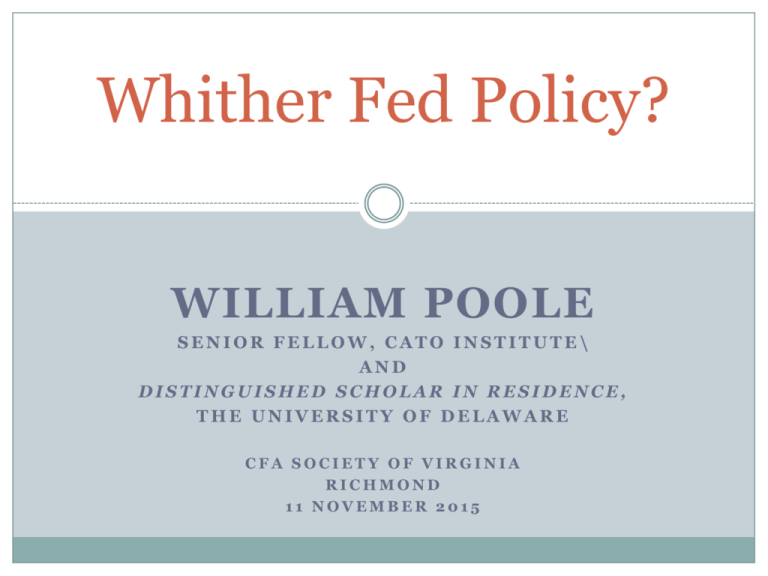
Whither Fed Policy? WILLIAM POOLE SENIOR FELLOW, CATO INSTITUTE\ AND DISTINGUISHED SCHOLAR IN RESIDENCE, THE UNIVERSITY OF DELAWARE CFA SOCIETY OF VIRGINIA RICHMOND 11 NOVEMBER 2015 Outline 2 Will begin with summary view of economy. Then, will discuss FOMC communications strategy. Finally, will speculate on future Fed policy. Non-Farm Employment 3 Ratio Scale Employment about 10 million below full employment Weakest Employment Recovery Since 1945 Prime-Age Employment/Population 4 Ratio Scale Males 2554 (right scale) Left scale All workers 25-54 (right scale) Cyclical and secular decline in labor-force participation. Productivity 5 Manufacturing productivity growth has slowed dramatically. Non-farm business productivity growth almost nil. Result is Slow GDP Growth 6 Simple growth accounting: %Δ GDP ≈ %Δ Employ + %Δ Prod Real GDP Line shows average growth 1947-2015 Q3 = 3.1% 2009 Q2 to 2015 Q3 up 2.1 % average annual rate Investment Is Key 7 We knew residential investment would recover slowly. But business fixed investment lagging badly despite low interest rates. Non-residential Fixed Investment Ratio scale 8 Structures Nonres index about the same as 1980 Total non-res fixed I index The big issue is why the slow recovery. Projections, FOMC Participants December 2012 9 GDP actual U Rate, Actual 2.2 7.8 1.5 1.5 2.2 (estimated) 7.0 5.7 5.0 (estimated) Is Fed on Cusp of Raising Rates? 10 Maybe. Will Economy Support Higher Rates? Real rate of interest a non-monetary phenomenon. A cautionary example -- Japan Cautionary Example-Japan 11 Would it have been feasible for BOJ t0 have continued to raise rates? 12/2000 Japan’s bubble burst a quarter century ago. Does it make any sense to believe that interest rates today still reflect that event all those years ago? Liftoff! 02/2006 FOMC Guidance 12 Have reviewed the projections, which have not been very accurate. Rate guidance through “dot” diagram. WSJ, p.A2, Sept. 18, 2015 13 Dot chart seemed very convenient way back when. FOMC never considered how it would get out from under it. FOMC has been saying since late 2012 that 2015 is likely to be the year. Inconsistent with idea of “data dependent” policy. What Is Market’s Guess? 14 As of yesterday’s close, fed funds futures market put probability of December rate hike at 68 %. CME Fed Watch June 2016 15 FOMC Communication Failure 16 Even today, shortly before December FOMC meeting, market does not believe the forward guidance. Forward guidance a mistake because things happen that change the appropriate policy action. Difficult for FOMC to back away from prior guidance. A Prior Example: FOMC Policy 2006-07 17 August 8, 2006: “The Federal Open Market Committee decided today to keep its target for the federal funds rate at 5-1/4 percent. … Nonetheless, the Committee judges that some inflation risks remain. The extent and timing of any additional firming that may be needed to address these risks …” August 7, 2007: “…the Committee's predominant policy concern remains the risk that inflation will fail to moderate as expected.” [Emphasis added] FOMC’s Flawed Communication Strategy 18 The Committee adopts language without paying adequate attention to how to exit from that language. In 2007, FOMC forced by events to abandon language hinting that no fed funds rate cut was being contemplated. Dot chart has created a time-dependent policy. Will it take a surge of inflation to force the FOMC to begin liftoff? Events plus possible Yellen speeches could abandon 2015 liftoff. Or, maybe not. Fed funds Futures, Feb 2016 Contract 19 25-50 bps FOMC target range 50-75 Daily close Mkt guess based more on the economy than on what FOMC says. Average funds rate past 12 months = 12 bps = 99.88 2014 Source: CME Group FOMC Should Explain: 20 What is the policy strategy (the “product”)? How do we explain (“sell”) it and convince the market that it is a good policy? In the face of inevitable missteps, how do we maintain credibility (brand loyalty)? Dear FOMC: Please remember that product recalls create a problem for you and for the rest of us. Poor Policy Statements 21 Oct 2015 statement 577 words. Bloated. Includes: “The Committee continues to monitor inflation developments closely.” When would it not? June 2004 statement 219 words. Real Interest Rate Fundamentals 22 In the long run, a central bank controls the rate of inflation but not real magnitudes. This proposition accepted by all economists except for a few at the fringes. Most economists accept the Wicksellian model of the inflation process. Keys to Unlocking the Future Course of Real Interest Rates 23 What are the non-monetary conditions that have kept real rates so low for the past five years? Will these conditions change over the next five years? Observation 1 24 Low economic growth yields low real interest rates in free capital markets. Example 1: Japan since 1990. Example 2: United States in 1930s. Observation 2 25 Poor government p0licy yields a low- growth economy. Extreme examples: Cuba North Korea China before 1979 Less extreme examples: Soviet bloc countries before 1990 Japan after 1990 Money-Market Interest Rates After 1831 26 Non-Monetary Disincentives 27 Regulatory burdens inhibit hiring and investment. Affordable Care Act Dodd-Frank Environmental policies block projects Prohibitions on tolls for bridges and highways. Businesses fear future tax increases on capital income. Prospects? These disincentives may remain in place for several or many more years. If so, Fed will keep interest rates below typical levels because demand for funds for capital investment will remain depressed. 2016 Election Will Matter for Growth 28 If current policies continue, real interest rates will remain below historical levels. Election of a Republican President likely to mean higher economic growth and higher real interest rates. Higher real rates could appear quite quickly. What are the odds? Recap 29 The central bank does not control the real rate of interest. Real magnitudes depend on real, nonmonetary conditions. Government policies that depress investment incentives also depress the real rate. Elections matter. Discussion 30 Questions? Disputes? Facts neglected?
